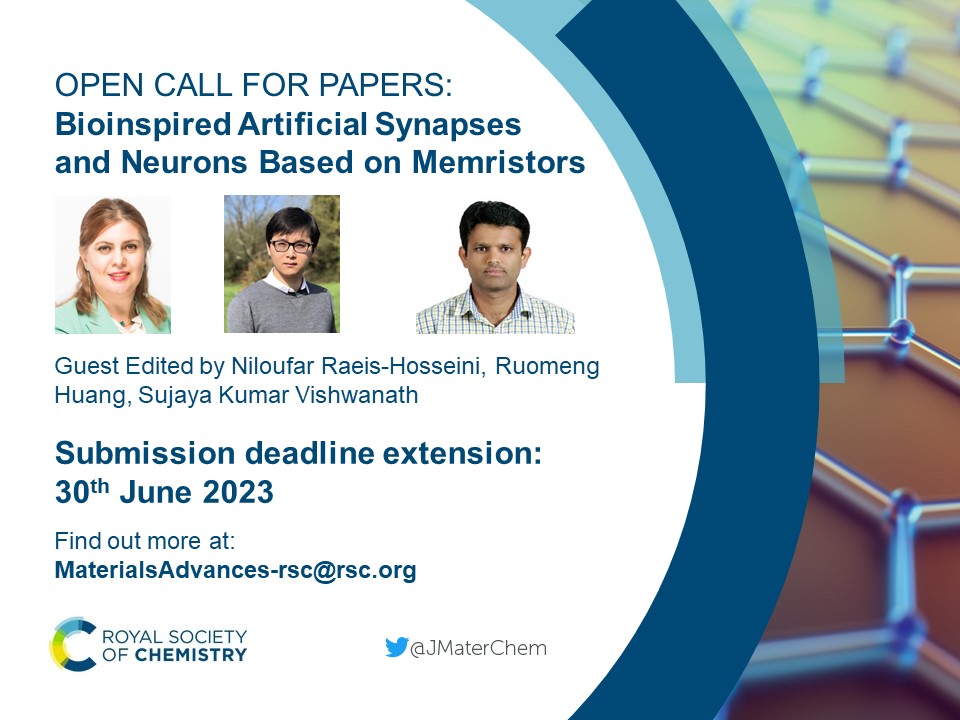We are delighted to announce a new themed collection on bioinspired artificial synapses and neurons based on memristors, to be published in Materials Advances, a gold open access journal from the Royal Society of Chemistry.
Guest Edited by Niloufar Raeis-Hosseini, Ruomeng Huang, and Sujaya Kumar Vishwanath.
Brain-inspired artificial synapses compute beyond the bottlenecks of von Neumann architectures by adapting highly sustainable information processing. Fabrication of artificial synapses in a physical device with the functionality of the biological neural network is an attractive research area. Complementary metal oxide semiconductor (CMOS) analog circuits emulate the synaptic performance of hardware-based neural networks. Since the hardware implementation of neuromorphic computation systems based on CMOS consumes much more energy than a natural system, numerous devices have been studied to realize an effective neuromorphic computing system. Among the proposed devices, memristors have emerged as the most efficient candidates to emulate biological synapses with high learning speed.
Memristors are two-terminal nanoelectronic devices with low power consumption, sustainable scaling, cost-effectiveness, and superior computing efficacy. They process information and compromise various fundamental operations that surpass typically integrated circuit technology. The temporal switching recommends that memristors are capable of acting as a physical system that imitates the synaptic memory function more precisely than the CMOS system.
This themed collection aims to highlight the recent developments, opportunities, and challenges in memristors and their applications in neuromorphic devices. We will outline the recent advances in neuromorphic nanodevices based on memristors by focusing on their fabrication and characterization methods. We will emphasize emerging bioinspired memristive devices and their improved performance by device structure and applied pulses engineering. We will also present outlooks of nanoelectronic devices and nanomaterials such as 2D materials, hybrid perovskites, and natural polymers.
We welcome contributions on memristors and artificial synapses in the form of research articles, communications, and reviews in the following categories.
Novel nanomanufacturing and processing methods of memristors:
- Fabrication and characterization of memristors, memtransistors, and memcapacitors
- Novel top-down and bottom-up approaches for nanofabrication of memristors
- Specified electrical and structural characterization techniques
- Novel approaches to realize flexible or rigid electronic synapses
- Novel nanomaterials and device structures to increase memristive device reliability and performance
Novel Memristive Materials:
- 2D materials such as graphene, phosphorene, and transition metal dichalcogenides
- Renewable materials, including biodegradables and biocompatible materials
- Organic and bio-electronic materials
- Heterogenous structures with organic-inorganic hybrid materials
- Flexible memristive materials
Emerging memristive devices and architectures:
- Biomemristors
- Optoelectronic memristors
- Ferroelectric memristive systems
- Spintronic memristors
- Assimilation of nanomaterials in neuromorphic computing systems based on memristors
Memristive devices enabled neuromorphic computing applications:
- Artificial synapses and neurons
- Artificial synapses by renewable materials
- Photonic and optoelectronic synapses
- Artificial neural networks
- Convolutional neural networks
- Recurrent neural networks such as reservoir computing
- Logic-in-memory system
- Neuromorphic and bio-inspired circuits and systems
- Explanation of operational principle of artificial synapses via modeling
Keywords: memristor, nanoelectronics, neuromorphic computing, artificial synapse, brain-inspired nanodevice
New submission deadline: Submit before 30 June 2023!
All submitted papers will go through the standard peer review process of Materials Advances and should meet the journal’s standard requirements as well as fit into the general scope of materials science.
Manuscripts can be submitted here https://mc.manuscriptcentral.com/ma
Please add a “note to the editor” in the submission form when you submit your manuscript to say that this is a submission for the themed collection. The Editorial Office and Guest Editors reserve the right to check suitability of submissions in relation to the scope of the collection and inclusion of accepted articles in the collection is not guaranteed. Accepted manuscripts will be added to the collection as soon as they are online, and they will be published in a regular issue of Materials Advances.











